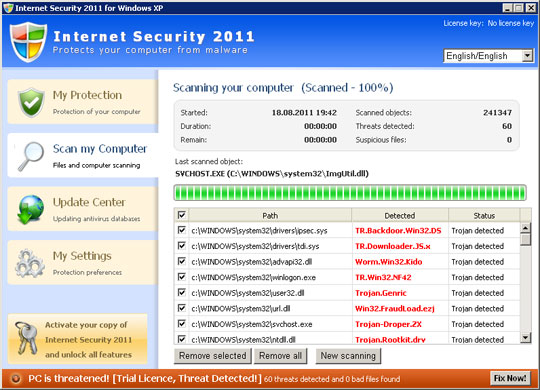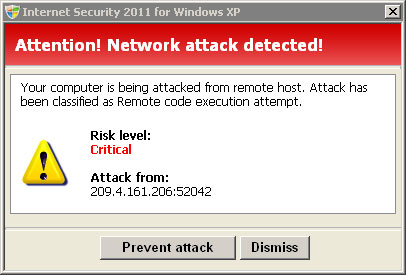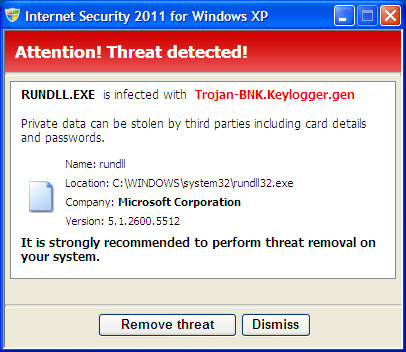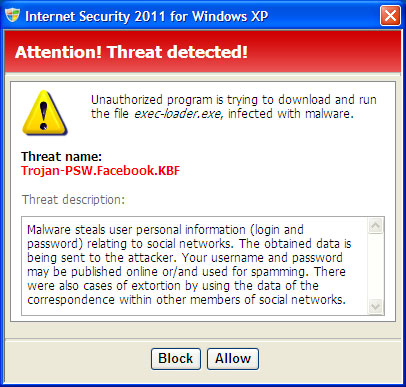TROJ_FAKEAV.SMDJ
Trojan.Gen (Symantec); Trojan:Win32/Malagent (Microsoft); Trojan.Win32.FakeAV.ahjm (Kaspersky); Generic.dx!vxo (Mcafee); Mal/FakeAV-IS (Sophos)
Windows 2000, Windows XP, Windows Server 2003


Threat Type: Trojan
Destructiveness: No
Encrypted: Yes
In the wild: Yes
OVERVIEW
This Trojan arrives on a system as a file dropped by other malware or as a file downloaded unknowingly by users when visiting malicious sites.
As of this writing, the said sites are inaccessible.
It deletes the initially executed copy of itself.
It displays fake alerts that warn users of infection. It also displays fake scanning results of the affected system. It then asks for users to purchase it once scanning is completed. If users decide to purchase the rogue product, users are directed to a certain website asking for sensitive information, such as credit card numbers.
TECHNICAL DETAILS
808,448 bytes
EXE
Yes
20 Jun 2011
Displays graphics/image
Arrival Details
This Trojan arrives on a system as a file dropped by other malware or as a file downloaded unknowingly by users when visiting malicious sites.
Installation
This Trojan drops the following files:
- %System%\exefile.exe - also detected as TROJ_FAKEAV.SMDJ
- %System%\us?rinit.exe - also detected as TROJ_FAKEAV.SMDJ
- %System%\ms{6 random characters}.dll - encrypted file that contains HTML codes for its GUI (Graphical User Interface)
- %System Root%\Documents and Settings\All Users\Application Data\.wtav - contains the license of the rogue antivirus
(Note: %System% is the Windows system folder, which is usually C:\Windows\System32.. %System Root% is the root folder, which is usually C:\. It is also where the operating system is located.)
It adds the following processes:
- svchost.exe
Autostart Technique
This Trojan registers itself as a system service to ensure its automatic execution at every system startup by adding the following registry entries:
HKEY_LOCAL_MACHINE\SYSTEM\CurrentControlSet\
Services\userinit
Start = 2
HKEY_LOCAL_MACHINE\SYSTEM\CurrentControlSet\
Services\userinit
Type = 10
HKEY_LOCAL_MACHINE\SYSTEM\CurrentControlSet\
Services\userinit
ErrorControl = 0
HKEY_LOCAL_MACHINE\SYSTEM\CurrentControlSet\
Services\userinit
ObjectName = LocalSystem
HKEY_LOCAL_MACHINE\SYSTEM\CurrentControlSet\
Services\userinit
DisplayName = Antivirus 2010
HKEY_LOCAL_MACHINE\SYSTEM\CurrentControlSet\
Services\userinit
Description = AV software
HKEY_LOCAL_MACHINE\SYSTEM\CurrentControlSet\
Services\userinit
ImagePath = \.\globalroot\systemroot\system32\us?rinit.exe
Other System Modifications
This Trojan adds the following registry entries:
HKEY_LOCAL_MACHINE\SOFTWARE\Microsoft\
Windows\CurrentVersion\Uninstall\
{random}
DisplayName = Antivirus 2010
HKEY_LOCAL_MACHINE\SOFTWARE\Microsoft\
Windows\CurrentVersion\Uninstall\
{random}
URLInfoAbout = http://www.webtopbilling.com/
HKEY_LOCAL_MACHINE\SOFTWARE\Microsoft\
Windows\CurrentVersion\Uninstall\
{871ED5A2-7AE2-E19B-4F38-5B8C6A4FCE0C}
UninstallString = \.\globalroot\systemroot\system32\us?rinit.exe /uninstall
HKEY_LOCAL_MACHINE\SOFTWARE\Microsoft\
Windows\CurrentVersion\Uninstall\
{871ED5A2-7AE2-E19B-4F38-5B8C6A4FCE0C}
DisplayIcon = \.\globalroot\systemroot\system32\us?rinit.exe
It adds the following registry keys as part of its installation routine:
HKEY_CLASSES_ROOT\Interface\{random CLSID}
HKEY_LOCAL_MACHINE\SOFTWARE\Microsoft\
Windows\CurrentVersion\Uninstall\
{random}
It modifies the following registry entries:
HKEY_CLASSES_ROOT\exefile\shell\
open\command
(default) = "exefile" /shell <%1> %*
(Note: The default value data of the said registry entry is "%1" %*.)
HKEY_LOCAL_MACHINE\SYSTEM\CurrentControlSet\
Services\wscsvc
Start = 4
(Note: The default value data of the said registry entry is 2.)
HKEY_USERS\.DEFAULT\Software\
Microsoft\Windows\CurrentVersion\
Explorer\Shell Folders
Cookies = %System%\config\systemprofile\Cookies
(Note: The default value data of the said registry entry is %System Root%\Documents and Settings\NetworkService\Cookies.)
HKEY_USERS\.DEFAULT\Software\
Microsoft\Windows\CurrentVersion\
Explorer\Shell Folders
Local AppData = %System%\config\systemprofile\Local Settings\Application Data
(Note: The default value data of the said registry entry is %Application Data%.)
HKEY_USERS\.DEFAULT\Software\
Microsoft\Windows\CurrentVersion\
Explorer\Shell Folders
Cache = %System%\config\systemprofile\Local Settings\Temporary Internet Files
(Note: The default value data of the said registry entry is %System%\Documents and Settings\NetworkService\Local Settings\Temporary Internet Files.)
HKEY_USERS\.DEFAULT\Software\
Microsoft\Windows\CurrentVersion\
Explorer\Shell Folders
History = %System%\config\systemprofile\Local Settings\History
(Note: The default value data of the said registry entry is %System Root%\Documents and Settings\NetworkService\Local Settings\History.)
Download Routine
This Trojan connects to the following URL(s) to download its component file(s):
- http://{BLOCKED}199.168/ask?t={value}&u={value}&a={value}&m={value}&h={value}
It saves the files it downloads using the following names:
- %System%\drivers\vbma{4 random characters}.sys - detected as RTKT_SIREFEF.AD
(Note: %System% is the Windows system folder, which is usually C:\Windows\System32.)
As of this writing, the said sites are inaccessible.
Other Details
This Trojan deletes the initially executed copy of itself
Rogue Antivirus Routine
This Trojan displays fake alerts that warn users of infection. It also displays fake scanning results of the affected system. It then asks for users to purchase it once scanning is completed. If users decide to purchase the rogue product, users are directed to a certain website asking for sensitive information, such as credit card numbers.
NOTES:
Below are screenshots of its GUI (Graphical User Interface):


It displays the following warning message whenever an EXE file is executed:

It may install itself as a rogue antivirus using any of the following names:
- Antivirus 2010
- Internet Security 2011
- Internet Security 9000
Once the user decides to purchase the rogue product it may connect to any of the following URLs to retrieve user information:
- http://{BLOCKED}230.15/test/activator.html?product=test
- https://{BLOCKED}.2010billing.com/purchase/get.php?i=antvir
- https://{BLOCKED}.exbilling.com/get/product.php?id=intsec
It may also access any of the following URLs when the user chooses to activate the rogue product:
- https://{BLOCKED}.2010billing.com/order/activate.php?orderid={random}
- https://{BLOCKED}.exbilling.com/get/activate.php?orderid={random}
In its body are the following hard-coded detections for its fake scanning results:
- advapi32.dll - name: "Worm.Win32.Kido", threat: 'virus'
- dialer.exe - name: "Backdoor.Dialer.W32", threat: 'trojan'
- explorer.exe - name: "Trojan.Sality.ag", threat: 'virus'
- explorer.exe - name: "Trojan/Agent.NFK", threat: 'trojan'
- iexplore.exe - name: "AdWare.Redirect.xt", threat: 'adware'
- ipsec.sys - name: "TR.Backdoor.Win32.DS", threat: 'adware'
- msoe.dll - name: "Email.Win32.Merond", threat: 'virus'
- ntdll.dll - name: "Backdoor.Win32.SdBot", threat: 'trojan'
- ntdll.dll - name: "Trojan.Rootkit.drv", threat: 'trojan'
- svchost.exe - name: "Trojan-Droper.ZX", threat: 'trojan'
- tdi.sys - name: "TR.Downloader.JS.x", threat: 'trojan'
- url.dll - name: "Win32.FraudLoad.ezj ", threat: 'trojan'
- user32.dll - name: "Trojan.Genric", threat: 'trojan'
- virus.sys - name: "Trojan.Nepster.a", threat: 'malware'
- winlogon.exe - name: "TR.Win32.NF42", threat: 'trojan'
It monitors the following URLs:
- .*.bankofamerica.com
- .*.contacts.msn.com
- .*.date.com
- .*.gmail.com
- .*.mail.yahoo.com
- .*.match.com
- .*.msg.yahoo.com
- .*.oscar.aol.com
- .*.paypal.com
- .*.twitter.com
- .*mail.aol.com
- login.icq.com
- login.live.com
- mail.google.com
- secure.friendfinder.com
- signin.ebay.com
- www.facebook.com
When the user accesses the said URLs, it will display the following warning message:

It blocks access to the following URLs:
- .*.search.com
- .*search.yahoo.*
- bing.*
- google.*
- live.*
- www.bing.*
- www.google.*
- www.live.*
SOLUTION
8.900
8.237.00
20 Jun 2011
Step 1
Before doing any scans, Windows XP, Windows Vista, and Windows 7 users must disable System Restore to allow full scanning of their computers.
Step 2
Remove the malware/grayware file dropped/downloaded by TROJ_FAKEAV.SMDJ
RTKT_SIREFEF.AD
Step 3
Restart in Safe Mode
Step 4
Restore this modified registry value
Important: Editing the Windows Registry incorrectly can lead to irreversible system malfunction. Please do this only if you know how to or you can seek your system administrator’s help. You may also check out this Microsoft article first before modifying your computer's registry.
HKEY_CLASSES_ROOT\exefile\shell\open\commandStep 5
Delete this registry key
Important: Editing the Windows Registry incorrectly can lead to irreversible system malfunction. Please do this step only if you know how or you can ask assistance from your system administrator. Else, check this Microsoft article first before modifying your computer's registry. Before you could do this, you must restart in Safe Mode. For instructions on how to do this, you may refer to this page If the preceding step requires you to restart in safe mode, you may proceed to edit the system registry.
- In HKEY_LOCAL_MACHINE\SYSTEM\CurrentControlSet\Services
- userinit
- userinit
- In HKEY_LOCAL_MACHINE\SOFTWARE\Microsoft\Windows\CurrentVersion\Uninstall
- {random}
- {random}
- In HKEY_CLASSES_ROOT\Interface
- {random CLSID}
- {random CLSID}
Step 6
Restore this modified registry value
Important: Editing the Windows Registry incorrectly can lead to irreversible system malfunction. Please do this step only if you know how or you can ask assistance from your system administrator. Else, check this Microsoft article first before modifying your computer's registry.
- In HKEY_LOCAL_MACHINE\SYSTEM\CurrentControlSet\Services\wscsvc
- From: Start = 4
To: 2
- From: Start = 4
- In HKEY_USERS\.DEFAULT\Software\Microsoft\Windows\CurrentVersion\Explorer\Shell Folders
- From: Cookies = %System%\config\systemprofile\Cookies
To: %System Root%\Documents and Settings\NetworkService\Cookies
- From: Cookies = %System%\config\systemprofile\Cookies
- In HKEY_USERS\.DEFAULT\Software\Microsoft\Windows\CurrentVersion\Explorer\Shell Folders
- From: Local AppData = %System%\config\systemprofile\Local Settings\Application Data
To: %Application Data%
- From: Local AppData = %System%\config\systemprofile\Local Settings\Application Data
- In HKEY_USERS\.DEFAULT\Software\Microsoft\Windows\CurrentVersion\Explorer\Shell Folders
- From: Cache = %System%\config\systemprofile\Local Settings\Temporary Internet Files
To: %System%\Documents and Settings\NetworkService\Local Settings\Temporary Internet Files
- From: Cache = %System%\config\systemprofile\Local Settings\Temporary Internet Files
- In HKEY_USERS\.DEFAULT\Software\Microsoft\Windows\CurrentVersion\Explorer\Shell Folders
- From: History = %System%\config\systemprofile\Local Settings\History
To: %System Root%\Documents and Settings\NetworkService\Local Settings\History
- From: History = %System%\config\systemprofile\Local Settings\History
Step 7
Search and delete this file
%System Root%\Documents and Settings\All Users\Application Data\.wtav
Step 8
Restart in normal mode and scan your computer with your Trend Micro product for files detected as TROJ_FAKEAV.SMDJ. If the detected files have already been cleaned, deleted, or quarantined by your Trend Micro product, no further step is required. You may opt to simply delete the quarantined files. Please check this Knowledge Base page for more information.
Did this description help? Tell us how we did.

